The Moulin Rouge is located in the heart of Paris’s Montmartre district. This area, known for its rich artistic heritage and lively nightlife, provides the perfect backdrop for the iconic cabaret. Positioned at the foot of Montmartre hill, the venue is just a stone’s throw away from the bustling Place Blanche and the famous Pigalle district.

Behind the scarlet curtain: Unveiling Moulin Rouge’s enchanting legacy
For more than 130 years, the Moulin Rouge has been the stage where can-can skirts swirl, bold art breaks boundaries, and Parisian glamour comes alive. Since its debut in 1889, this legendary cabaret has embodied the city’s rebellious spirit and tr...
Also Known As
The Red Mill
Founded On
1889
Founded By
Joseph Oller and Charles Zidler
Quick Information
RECOMMENDED DURATION
4 hours
Timings
19:00–01:00
VISITORS PER YEAR
600000
TICKETS
From € 120
EXPECTED WAIT TIME - STANDARD
1-2 hours (Peak), 30-60 mins (Off Peak)
EXPECTED WAIT TIME - SKIP THE LINE
0-30 mins (Peak), 30-60 mins (Off Peak)
Did you know?
The Moulin Rouge was the first building in Paris to shine with electric lights, its colorful facade designed by Adolphe Léon Willette to sparkle across Montmartre.
Every sequin and feather on the costumes is handcrafted by a dedicated on-site atelier, working around the clock to keep the magic alive.
Since 1957, every show starts with the letter “F,” a tradition sparked by Doris Haug’s belief that these names would bring great success— the superstition still holds strong today.
Book your Moulin Rouge Paris tickets
Navigate your Moulin Rouge Paris guide
💡 The philosophy
🎭 What influenced Moulin Rouge?
💃🏻 Doriss Girls
🪭 The windmill venue
🎞️ Moulin Roue & pop-culture
❓ Your FAQs answered
History of Moulin Rouge Paris

Founding and early years (1889-1900)
The Moulin Rouge opened in Paris’s Montmartre district on October 6, 1889, co-founded by Joseph Oller and Charles Zidler. With its red windmill and extravagant decor, it quickly became a symbol of the Belle Époque, catering to both the wealthy and the working class. Its debut coincided with the 1889 Exposition Universelle, helping it become a must-see attraction in Paris.
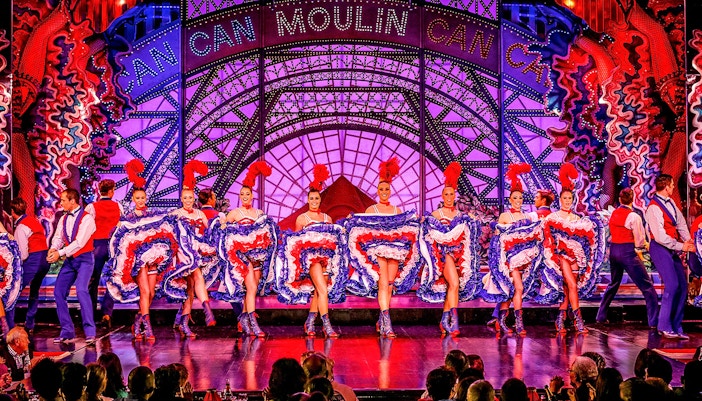
The rise of French cancan (1890s)
By the 1890s, the Moulin Rouge became synonymous with the French cancan, a high-energy, provocative dance that captivated audiences. The Dames de la Canne dazzled with their athleticism and flair, and the cancan soon became the venue’s signature performance, symbolizing the joy and freedom of the era.
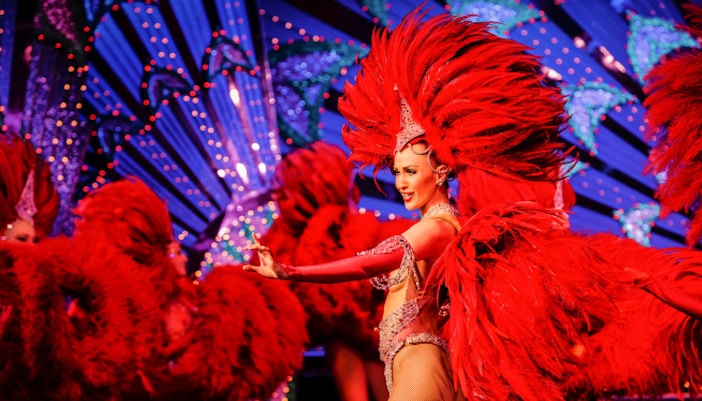
The role of Toulouse-Lautrec
Artist Henri de Toulouse-Lautrec immortalized the Moulin Rouge with his iconic posters. His vibrant works captured the energy of the cabaret and spread its fame beyond Paris. Through his art, the Moulin Rouge became a global symbol of Parisian nightlife, adding an artistic dimension to its cultural status.
Challenges and survival (1900-1945)
Transitioning through the early 20th-century
In the early 1900s, the Moulin Rouge shifted from cancan to operettas, drawing new audiences. The 1900 Universal Exhibition solidified its reputation, but in 1915, a fire destroyed the venue during World War I. Despite the setback, the Moulin Rouge reopened in 1921, surviving both the war and the challenges of the Great Depression.
Survival during wartime
During WWII, the Moulin Rouge remained open, serving German soldiers during the occupation. Despite the difficult circumstances, the cabaret endured. In the final days before Paris's liberation, Édith Piaf performed there, becoming a symbol of resistance and resilience, embodying the spirit of the Moulin Rouge during the darkest times.
Post-war renaissance (1945-1960s)
Modernization and innovation
After the war, Jo France took over the Moulin Rouge in 1951, modernizing it with renovations and introducing dinner shows that combined fine dining with entertainment. In the 1960s, Jacki Clérico brought aquatic ballets and introduced a superstition of naming shows with the letter “F,” beginning with Frou Frou in 1963, ensuring the venue’s ongoing popularity.
The Moulin Rouge in the 1960s-1970s
With Jacki Clérico at the helm, the 1960s and 1970s saw the Moulin Rouge embrace a blend of traditional cabaret and modern spectacle. The introduction of aquatic ballets and continued innovation in performances ensured the venue remained at the forefront of Parisian entertainment, captivating both locals and tourists alike.
Global revival and modern influence (1980s-present)
Revival and globalization (1980s-1990s)
In the 1980s and 1990s, the Moulin Rouge saw an international revival. Global tourism flocked to Paris to witness its storied performances. The venue underwent renovations to maintain its grandeur, continuing to symbolize the bohemian spirit of Paris while embracing modern elements to keep its appeal fresh.
Moulin Rouge today
The Moulin Rouge’s influence extended into films, most notably in Baz Luhrmann’s 2001 movie Moulin Rouge!. The film introduced the cabaret to a new generation, cementing its place as an icon of Parisian creativity and exuberance, further securing its legacy in popular culture.

The mood lighting
Lighting at the Moulin Rouge isn’t just there to brighten the stage—it’s a key player in telling the story. The lights shift and change throughout the show, responding to the rhythms of the music and the emotions of the dancers. This creates an ever-changing atmosphere that brings each performance to life, adding depth and drama to the experience.
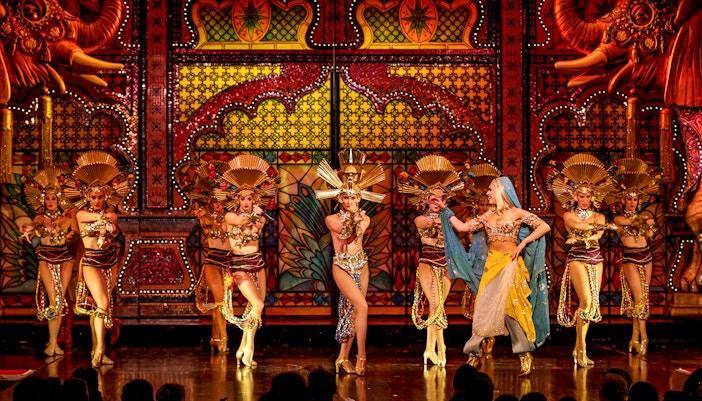
The well-thought choreography
The choreography, too, goes beyond just dancing. Each routine tells a story—sometimes playful, sometimes passionate—but always emotionally engaging. With live music, intricate costume changes, and moves that flow seamlessly together, the performances are a feast for both the eyes and the soul. It’s a blend of theater, dance, and music that invites you to feel every moment.
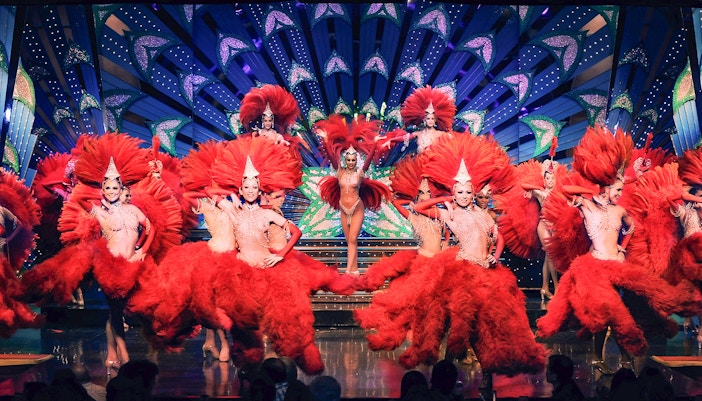
A space for freedom and empowerment
The Moulin Rouge was built on a bold idea: to be a place where women could freely express themselves through dance and performance. In a time when society was rigid and male-dominated, this vision was revolutionary. Today, it stands as a symbol of empowerment, embracing the strength and creativity of women and celebrating their voices on stage.
Despite the challenges the Moulin Rouge has faced over the years—from financial struggles to societal criticism—it has remained true to its roots.
Doriss Girls: The artists of Moulin Rouge Paris
Moulin Rouge wouldn’t be what it is today without its Doriss Girls: the troupe of dancers at the cabaret. Founded by choreographer Doris Haug in 1957, the group has grown from four dancers to about 60, becoming a symbol of the Moulin Rouge's reputation for top-tier entertainment.
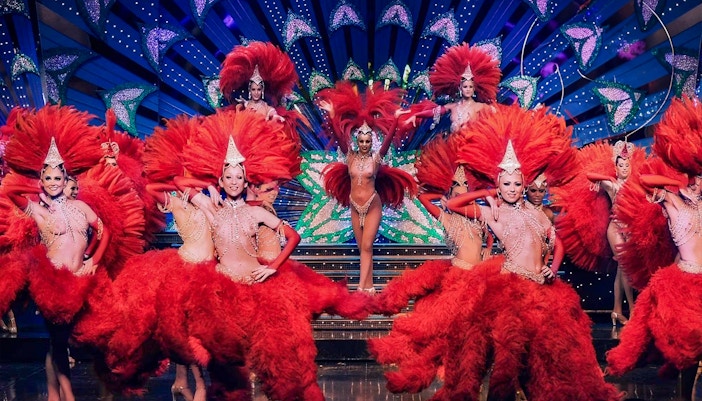
Dance style and performance
The French cancan, a high-energy dance with kicks, acrobatics, and colorful costumes, is one of the troupe’s signature moves. The routine requires exceptional skill, including pirouettes and splits, all performed with athletic precision and flair.

A day in the life
Training is rigorous for a Doriss Girl, with daily rehearsals, warm-ups, and makeup sessions to prepare for performances. Staying in peak physical condition is crucial for the demanding shows, which are held several times a week and last about three and a half hours, divided into two acts.

Costumes and visuals
The visual spectacle of the Doriss Girls is just as stunning as the dance itself. Each dancer wears elaborate costumes adorned with feathers, sequins, and rhinestones. The Moulin Rouge boasts over 1,000 unique costumes, and the stage design enhances the performances with rich colors and intricate patterns, making each show a visual masterpiece.
The location

In films
Perhaps one of the most famous adaptations is Baz Luhrmann's 2001 film Moulin Rouge!, which blended the cabaret’s rich history with modern music to create a visually stunning, emotional spectacle. This film not only rekindled interest in the cabaret but also introduced its legendary legacy to new generations, cementing its place in the cultural zeitgeist.

In literature
The Moulin Rouge has inspired countless works of literature and songs over the years. Its electric atmosphere and storied history have served as a muse for artists across genres, like Moulin Rouge by Pierre La Mure and Revelle by Lyssa Mia Smith.
Frequently asked questions about Moulin Rouge Paris
While the main attraction is its live performances, you can explore the exterior and iconic red windmill. Inside access is typically reserved for show attendees.
The cabaret honors its history through meticulously choreographed revues, featuring costumes, music, and dance styles reflective of Paris's Belle Époque era.
The cancan began as a rebellious dance in Parisian working-class culture but was elevated to an art form at the Moulin Rouge, becoming a symbol of liberation and joy.
The Moulin Rouge popularized the cancan dance, setting a global standard for cabaret shows. Its mix of glamour, innovation, and tradition has been replicated in venues around the world.
While the shows primarily use music and dance to tell stories, eliminating language barriers, announcements and information are often available in multiple languages for international guests.
Yes, the venue often incorporates elements of opera, ballet, and contemporary music into its shows, creating a multidisciplinary artistic experience.
- The original building burned down in 1915 and was rebuilt in 1921.
- It has inspired countless replicas and homages worldwide, from Las Vegas to Tokyo.
- The venue's iconic cancan was initially considered scandalous before it gained cultural acclaim.
The red windmill is a symbol of the Moulin Rouge, created to make the cabaret stand out when it opened in 1889. Inspired by traditional French windmills in Montmartre, it became the venue's signature feature. The windmill not only represents the name "Moulin Rouge" (which translates to "Red Mill") but also embodies the artistic and bohemian spirit of the area.
The original Moulin Rouge was destroyed by a fire in 1915. It was rebuilt and reopened in 1925, with a fresh focus on its cabaret traditions. Over the years, it has undergone renovations to maintain its iconic status.
The Moulin Rouge has hosted numerous legendary performers over the years. In its early days, dancers like La Goulue and Jane Avril became icons, and the venue was a favorite haunt of artists like Henri de Toulouse-Lautrec, whose posters helped cement the cabaret’s global fame. Later, stars like Mistinguett, Édith Piaf, and Yves Montand further solidified the Moulin Rouge’s reputation as the heart of Parisian nightlife.






